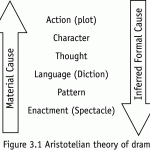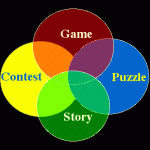2004
Sidebar images, "From Work to Play: Molecular Culture in the Time of Deadly Games."
Alex Reid examines a cross-section of essays in Prefiguring Cyberculture, a work that historicizes the future as neither alarmist nor utopian.
Pat Harrigan and Noah Wardrip-Fruin introduce First Person, an interactive, multi-player collaboration between ebr and the MIT Press.
Animals and invaders populate the space of Janet Murray's counter-response.
Insisting on the centrality of character (in literature no less than gaming) Ken Perlin responds to Victoria Vesna and Will Wright.
Narrativists vs. ludologists, material vs. formal constraints: Michael Mateas replies by identifying actors' roles in each division.
The builder of Façade, an "interactive story world," Michael Mateas offers both a poetics and a neo-Aristotelian project (for interactive drama and games).
Illustrating Perlin's "Can There Be a Form between a Game and a Story?"
Ken Perlin on a game-narrative difference that makes a difference: does agency, rather than identifiction, make characters in a game seem more real than those in novels or films?
The importance of consequences plots Brenda Laurel's response to Michael Mateas.
Bryan Loyall cites expertly paced penguins in this response to Janet Murray.
Pat Harrigan and Noah Wardrip-Fruin introduce Cyberdrama, the first section of First Person.
Moving from the holodeck to the game board, Janet Murray explains why we make dramas of digital simulations.
Secret agency is at issue in Frasca's response, which denies the application of Aristotle to the open-ended interactivity of gaming.
In response to Perlin, Victoria Vesna reiterates the unique realism of games.
The man behind The Sims, Will Wright, places narrative controls back in the hands of gamers.
Sidebar images from "How I Was Played by Online Caroline."
Sidebar images from "Metaphoric Networks in Lexia to Perplexia."
A thirst for interaction fuels Adrianne Wortzel's response.



